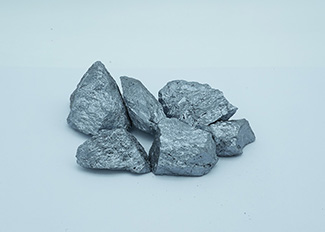- gzk@hnlcalloy.com
- +8615737205888
- Qugou Town, Anyang City, Henan Province
Silicon metal, also known as industrial silicon, is mainly used as an additive for non-ferrous alloys. It is a product smelted from quartz and coke in an electric furnace, with the main component of silicon about 98% or 99.99%, and the remaining impurities of iron, aluminum, calcium, etc.
Silicon metal is usually classified according to the content of three main impurities of iron, aluminum and calcium into different grades such as 553, 441, 411, 421, 3303, 3305, 2202, 2502, 1501, 1101 and so on.
Silicon metal, also known as industrial silicon, is mainly used as an additive for non-ferrous alloys. It is a product smelted from quartz and coke in an electric furnace, with the main component of silicon about 98% or 99.99%, and the remaining impurities of iron, aluminum, calcium, etc.
Silicon metal is usually classified according to the content of three main impurities of iron, aluminum and calcium into different grades such as 553, 441, 411, 421, 3303, 3305, 2202, 2502, 1501, 1101 and so on.
Industrially, silicon metal is usually produced by reducing silicon dioxide from carbon in an electric furnace. Chemical reaction equation: SiO2 + 2C → Si + 2CO The silicon produced in this way has a purity of 97~98 percent. Then it is melted and recrystallized, and impurities are removed with acid to obtain silicon metal with a purity of 99.7~99.8%.

For aluminum alloy products: adding silicon metal to aluminum alloy to improve its strength, increase its oxidation and corrosion resistance, reduce its density and thermal expansion coefficient, improve its casting performance, leading to higher impact resistance and pressure resistance.
For cold-rolled silicon steel products: Adding silicon metal to steel can greatly improve its magnetic properties, increase its permeability, and reduce hysteresis and eddy current loss.
For high-purity semiconductor products: Due to the high melting point of silicon, good thermal stability, large band gap, and abundant resources, with the continuous improvement of technology, integrated circuits and large-scale integrated circuits made of silicon semiconductors have been used in various fields, with increasing demand year by year.
For organic silicone products: organic silicone, silicone resin, and silicone oil maintain flexibility in the range of more than 700°C to 2000°C, and can be used for high-temperature gaskets and cold-preservation materials. Silicone resin: it is used in the production of insulating varnish, with the heating temperature of 180-2000°C, and can also be used in the production of high-temperature resistant coatings. Silicone oil: it is used in the production of high-grade lubricants, polishing agents, fluid springs, and dielectric fluids. It can also be processed into colorless transparent liquids and sprayed on buildings for waterproofing. Silicon metal has a tendency to be more widely used in the organic silicon industry than in the aluminum alloy industry.
For heat-resistant material products: it is used for the production of Si3N4, which is heat-resistant, wear-resistant, and corrosion-resistant, preventing coating materials from oxidation. Siliconizing steel surface can improve the corrosion resistance of steel.
| Model | Content (%) | |||
| Si>= | Fe | Al<= | Ca | |
| 553 | 98.5 | 0.5 | 0.5 | 0.3 |
| 521 | 99 | 0.5 | 0.2 | 0.1 |
| 441 | 99 | 0.4 | 0.4 | 0.1 |
| 421 | 99 | 0.4 | 0.2 | 0.1 |
| 411 | 99 | 0.4 | 0.1 | 0.1 |
| 3303 | 99 | 0.3 | 0.3 | 0.03 |
| 2202 | 99.5 | 0.2 | 0.2 | 0.02 |
| 1101 | 99.5 | 0.1 | 0.1 | 0.01 |
| Standard size: 10-100mm | ||||
| Standard packing: 1 ton/ladle | ||||
| Size and packaging can be customized according to customer requirements | ||||
The main products include rare earth magnesium ferrosilicon alloy (spheroidizing agent), nucleating agent, pipe powder, ferrosilicon (particles), (high, medium and low) carbon manganese, (high, medium, low and micro) ferrochromium, alloy cored wire, silicon carbide, silicon nitride, slag onglomeration agent, desulfurizer, and carburant, as well as other customized alloy products.